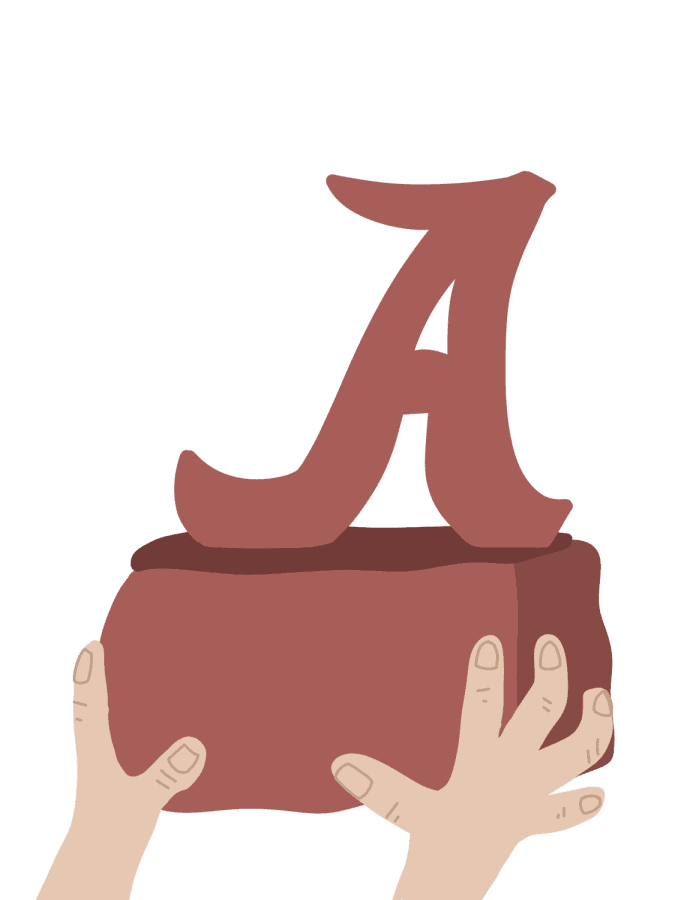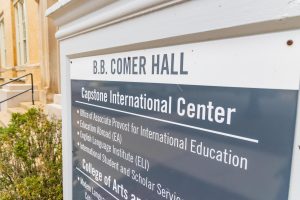Restorative justice rehabilitates
February 2, 2022
Though restorative justice may have had its start in the criminal law system, the term has broadened to address society on a larger scale and encourage the reflection of our history to spark more thoughtful conversations and purposeful change.
According to Edutopia, in the legal system, restorative justice emphasizes repairing the harm done to people and relationships by rehabilitating offenders and offering them a chance to reconcile with victims and the community rather than exclusively punishing them.
Advocates for restorative justice today suggest policymakers should aim to make justice systems truly correctional. By supporting the rehabilitation of offenders and offering them access to higher education, the chance to heal relationships, and acceptance when transferring back into the community, advocates hope to achieve lower recidivism rates.
Brenita Softley, a third-year UA law student, said restorative justice is about focusing on how people can be made whole again based on a justice system that is made to tear them down.
“Giving the option of restorative justice can help heal on both parts, so I think that’s really important to look at,” Softley said.
She said society needs to work on changing its implicit biases so that everyone can be seen as redeemable.
“In order to do that, we really need to focus on changing the way people think,” Softley said.
She hopes the criminal legal system today can start taking action toward rehabilitating offenders and opening up conversations that will lead to healing for every party in these situations.
“I think it’s really important to study the law through a lens of history, but also study the law through a lens of compassion as well,” Softley said. “Rather than just labeling the person as a ‘monster,’ or ‘unredeemable,’ restorative justice helps you to get past the things that you’ve done.”
History
The University of Alabama has a complex history, and professors on campus have been working to take a holistic approach to how its history is told.
This has been done through historical markers that honor the history and experiences of Black students at the University. Hilary Green, an associate professor of history in the Department of Gender and Race Studies created the Hallowed Grounds walking tour in 2016 “to shed light onto the lives, experiences and legacy of the many enslaved men, women and children who lived, worked and even died at the University of Alabama.”
It is important that the University makes this progress a sustained effort.
Jenny Shaw, an associate professor in the Department of History, said that in 2018 the Faculty Senate passed a resolution for the University to establish a formal commission to investigate the history of race, slavery and civil rights on campus.
According to the proposal, the resolution’s purpose is to share the “rich and diverse history of UA from its slave past to its continued trajectory toward becoming a more diverse and inclusive campus since the first African American students enrolled.”
“If we’re thinking about taking seriously the history of race, slavery and civil rights at The University of Alabama, the only way to do that is to look at all of it as holistically as possible,” Shaw said. “I don’t think that anything or anyone is benefited from turning away from things, or deciding that you don’t need to know the whole history.”
The Faculty Senate said this commission would build on previous efforts such as the slavery apology marker, the Autherine Lucy Foster historical marker, and Malone-Hood Plaza, to continue its strides toward a more inclusive and diverse campus.
“What I think is really important is that the whole process, and particularly the discoveries, are made as accessible as possible to anyone who wants to be able to see them,” Shaw said.
This work will enable the team to create a website displaying the University’s research, documents and history. After the website launches, the University will also be able to join the Universities Studying Slavery consortium, a multi-institutional collaboration focused on guiding truth-telling projects in institutional histories.
“It’s a very first step, but if it’s a step that leads to better, more productive conversations and then potentially and eventually some kind of action, that I think is what anyone would hope for in this kind of scenario,” Shaw said.
On campus
The University’s Division of Diversity, Equity and Inclusion has worked to implement values of inclusiveness across campus.
G. Christine Taylor, the University’s vice president and associate provost of diversity, equity and inclusion, said that in order for restorative justice to be effective, it must start small. Enacting real change, she said, requires difficult conversations.
“Nowadays … you’re able to say something or put something in the atmosphere and never fully understand the impact of what you did,” Taylor said.
Restorative justice enables offenders to understand the consequences of their behavior, see how a situation impacted lives, and take ownership and responsibility for their actions.
Taylor highlighted how restorative justice can inspire the ways people look at movement and change. For it to be implemented correctly, there must be full participation and authentic conversations.
“One of the biggest things that is missing from the justice conversation today is courage,” Taylor said. “I think people probably see a whole lot of stuff every day and hear a lot of stuff every day, but do they have the courage to disrupt that behavior?”
John Giggie, an associate professor in the history department, said restorative justice began as a concept in criminal law, aiming to give voices to individuals who were underrepresented and denied justice for too long.
However, he said restorative justice isn’t a punishment orientation, but a more empathetic type of reform; it has taken on a broader role that can be applied to law, American culture, communities and society in general.
Giggie said the University has enormous power within the state and region and, because of that, has the opportunity to be a leader in encouraging education, awareness and action toward restorative justice practices.
He said it is important to look at what restorative justice means for young people and the role the University plays in that, “not simply the University as a research mechanism, but as a teaching organization.”
Giggie has implemented courses and programs that allow students to further explore the subject matter that inspires them. Some of these include religious civil rights and queer history classes, a summer social justice academy, a program with the Equal Justice Initiative in Montgomery, and Black history classes at Central High School.
“I think part of the key is to imagine being an academic community in a different way. That means being ever more present and thoughtful of those that lived near us and around us, but aren’t necessarily part of our campus formally,” Giggie said.
He said he feels led by his students and locals in the Tuscaloosa community when it comes to identifying what type of action can be taken to engage individuals in these projects and better showcase Alabama’s history.
“I think their understanding of what constitutes value, what constitutes history, is something we don’t always pay attention to, but they can teach us a lot,” Giggie said.
Restorative justice requires people to push boundaries and think creatively to promote change and pave the way for the future. This practice sparks conversations of empathy for everyone involved.
By taking into account the harm that has been done to a community while also understanding the factors that caused the offender’s behavior, it is possible to work toward reconciliation and healing for everyone involved.
“What if we reorientate our understanding of kids acting out or youthful offenders and root it more in their mental health histories or family histories,” Giggie said. “Then all of a sudden that can lead to empathy and that can lead to policy change. I really believe that.”
There have also been moves toward restorative justice in the University’s theater department. Restorative justice as an art form requires the ability to take harmful words and imagery and remediate them into something to be celebrated and examined to empower future generations.
In this vein, the University’s production of “The Colored Museum,” a play composed of 11 separate “mini-plays” challenging and satirizing racial stereotypes and briefly diving into the experiences of queer people of color, is an act of restorative justice.
Christian Tripp, the play’s director and a full-time instructor in the theater department, said his main goal in choosing “The Colored Museum” was to find a play that would best serve the students on campus and the greater Tuscaloosa community.
Tripp described the play’s commentary as a great conversation starter on what it means to be Black in this period of history, even though the play was written decades ago.
“The big overall message I want the audience to walk away with is the questioning of their own preconceived notions of what it means to be Black,” Tripp said. “For a typical American, theatrical audience, for them to be able to go home and question what they laughed at. And for the atypical audience — the Black audience most often — for that perspective I would hope they would take away a sense of reclaiming their own images, their own voice, their own power.”
This story was published in the Justice Edition. View the complete issue here.
Questions? Email the Culture desk at culture@thecrimsonwhite.com.



















![UPDATE | New details have emerged about U.S. Immigration and Customs Enforcement’s arrest of doctoral student Alireza Doroudi.
— Yesterday, a University spokesperson confirmed that a doctoral student was arrested by federal immigration authorities, without providing the student’s name, declining to share specific information due to federal privacy laws.
“International students studying at the University are valued members of the campus community, and International Student and Scholar Services is available to assist international students who have questions,” said Alex House, associate director of media relations for the University. “UA has and will continue to follow all immigration laws and cooperate with federal authorities.”
— An employee at the Pickens County Jail confirmed that Doroudi is being held there, adding that the facility typically sends ICE detainees to a detention facility in Louisiana.
— The Department of Homeland Security provided a statement about Doroudi’s arrest:
“ICE HSI [Homeland Security Investigations] made this arrest in accordance with the State Department’s revocation of Doroudi’s student visa. This individual posed significant national security concerns,” a DHS spokesperson said. The statement did not provide details about why it claimed Doroudi posed national security concerns.
— Students for Justice in Palestine at UA, formerly known as Bama Students for Palestine, said in a statement on social media Thursday that it was “outraged” to learn of his detainment and that he "was not involved, nor has he ever been involved in any organizing or protests related to our organization."
This is a developing story and will continue to be updated. Read the updates at the link in our bio.](https://scontent-iad3-1.cdninstagram.com/v/t51.75761-15/486944895_18492822301025566_6944596333023050206_n.jpg?stp=dst-jpg_e35_tt6&_nc_cat=107&ccb=1-7&_nc_sid=18de74&_nc_ohc=hnp26Pzwsm0Q7kNvgH09W0S&_nc_oc=AdmIBEMuR_aRgaBd00Hlot3E59Vj_4lQyCImLLgp8CLdbxpSmLU25dhU_MO_Zul-qcU&_nc_zt=23&_nc_ht=scontent-iad3-1.cdninstagram.com&edm=AM6HXa8EAAAA&_nc_gid=Eef0YMIFzxMaiUpFitZOLg&oh=00_AYGXXmlh-QsW5bKnKx6w8LK3Rdz_HpdqlpeEraurXrQNsQ&oe=67F30BB0)

